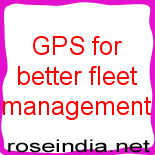GPS for better fleet management
GPS technology was developed by US for military purposes to help navigation in air, water as well as on land. Later it became indispensable in commercial areas. A group of satellites are used to send the received data back to receivers on the surface of the earth.
For tracing the time lag between the time code signal sent and the time it was actually received on earth GPS makes use of theory of relativity propounded by Einstein and four signals to provide accuracy.
Once the technology was confined to military domain, today it became a $15 billion industry. Mostly GPS is being used by the public transportation agencies as they generally have to deal with larger area. For example school buses in cities to keep the track of the buses to make safety of the passengers sure. GPS gives drivers information about the other vehicle so that on the basis of information received may align its own course avoiding traffic congestion. Thus keeping passengers safe and also saving time.
This also gives parents peace of mind as they find that vehicle carrying their children are regularly being monitored or kept watch.
In India, a fleet of one fifty GPS enabled metered taxis were launched in Mumbai. This enhanced fleet provided better customer services as they now were able to book a taxi in advance just by few strokes on internet or phone and call taxi at a preferred location. This added one more to the list of benefits to the customer that now customer will be charged appropriately as all the data regarding mileage will be sent back to the control centre. This also ensures the safety of the passenger as there are reduced chances of kidnapping or harming the passenger by virtue of monitoring of the vehicle.
In companies device is used to track especially supply trucks and trucks used by the contractors going to job sites. This permits real time tracking of the mobile asset. This also abridges the gap between the actual mileage and the bill paid for it. Transparency naturally comes in the system.
Thus tracking of vehicles reduces the cost of labour, fuel and culminates into the efficient service delivery system.



